Proceedings of the Sixth TRB Conference on the Application of Transportation Planning Methods
Personal travel behavior choices made by employees appear to be influenced by a number of urban design and urban form characteristics of their work place. Several important attributes include the density of development and the accessibility of non-work activities, such as eating at restaurants and shopping (frequently accompanied by a greater mix of land uses).
The research reported in this study focuses on travel choices made by employees during their commute to work and during their work day. Travel patterns were examined for employees in four different urban and suburban employment centers. The mix of uses varied from a virtual single use center to a full urban core with numerous types of activities. Walk accessibility to the various activity centers (or buildings) varied from site to site. The various sites also contain different levels of transit service.
Travel patterns recorded in a one-day diary format included the journey to work, trips made from the office to other non-work and work locations during the day, and the journey from work to home, including additional stops. These patterns resulted in trip chains of different lengths and different temporal distributions.
The research revealed strong relations between the various urban form/urban design characteristics and the total number of trips made per day, the total number of trips by individual modes (transit, walking, automobile), and the number of trips made by trip purpose. Differences in the number of auto starts and vehicle miles of travel were calculated. The data suggest dramatic differences in the travel patterns of employees with similar jobs and incomes depending on the urban character of the work place (including mix of land uses.)
An additional insight derived from the analysis was the difficulty in isolating the causal relationships between trip making and mode choice in relation to urban design, urban form and transit service variables. In many cases, the different characteristics of the travel experience occur in a synergistic format. For example, increased density, increased mix of uses, and high level transit service are all available at a single site. Another site may have a very low mix of uses, poor pedestrian accessibility and poor transit service, leading to either extremely high automobile use or reduced overall trip making.
https://ntlrepository.blob.core.windows.net/lib/7000/7500/7512/Dearborn.PDF


